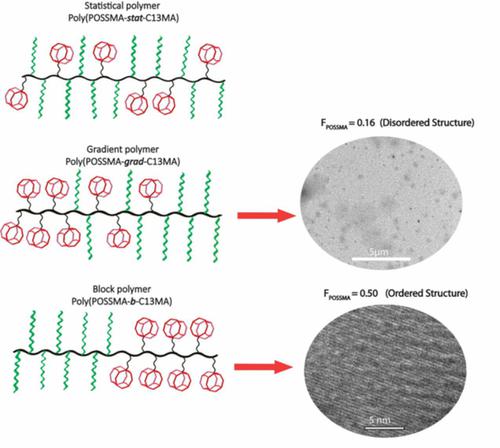当前位置:
X-MOL 学术
›
J. Polym. Sci.
›
论文详情
Our official English website, www.x-mol.net, welcomes your feedback! (Note: you will need to create a separate account there.)
Incorporation of POSS to improve thermal stability of bio‐based polymethacrylates by nitroxide‐mediated polymerization: Polymerization kinetics and characterization
Journal of Polymer Science ( IF 3.4 ) Pub Date : 2020-04-15 , DOI: 10.1002/pol.20200109 Faezeh Hajiali 1 , Milan Marić 1, 2
Journal of Polymer Science ( IF 3.4 ) Pub Date : 2020-04-15 , DOI: 10.1002/pol.20200109 Faezeh Hajiali 1 , Milan Marić 1, 2
Affiliation

|
Nitroxide‐mediated polymerization (NMP) was used to polymerize methacrylate‐functionalized polyhedral oligomeric silsesquioxane, POSSMA, in a controlled manner with bio‐based C13 methacrylate (C13MA) to improve the thermal stability of the latter by copolymerization (using 10 mol% acrylonitrile controlling comonomer). Kinetic experiments (80–110 °C) revealed the relatively low ceiling temperature of POSSMA (135 °C). Synthesis of poly(POSSMA‐co‐AN) with f
AN,0 = 0.10 at 90 °C resulted in low dispersity (1.16) and relatively high conversion (~50%) after 3 hr in 50 wt% toluene. Assuming binary statistical copolymerizations, POSSMA was slightly less reactive than C13MA toward the propagating species (r
POSSMA = 0.91 ± 0.07 and r
C13MA = 1.94 ± 0.13). Incorporating POSSMA up to 68 mol% improved decomposition temperature of C13MA‐based copolymers from 190 to 262 °C. Chain end fidelity of POSSMA‐rich compositions was confirmed by subsequent chain extensions to make block and gradient copolymers. Differential scanning calorimetry revealed multiple transition temperatures in block copolymers, suggesting microphase separation. Powder X‐ray diffraction confirmed crystalline domains ~30 nm in POSSMA‐rich statistical copolymers while transmission electron microscopy revealed weakly ordered lamellar morphology for poly(C13MA‐co‐AN)‐b‐(POSSMA‐co‐AN) block copolymer at a smaller length scale. Oscillatory shear measurements of block copolymers indicated primarily viscous character below 200 s−1 but crossover above this frequency, indicating POSS–POSS interactions were increasing the elasticity of the block copolymers.
中文翻译:

掺入POSS以通过一氧化氮介导的聚合反应改善生物基聚甲基丙烯酸酯的热稳定性:聚合动力学和表征
使用一氧化氮介导的聚合(NMP)与生物基C13甲基丙烯酸酯(C13MA)受控地聚合甲基丙烯酸酯官能化的多面体低聚倍半硅氧烷POSSMA,以通过共聚提高后者的热稳定性(使用10 mol%的丙烯腈控制)共聚单体)。动力学实验(80–110°C)显示POSSMA的最高天花板温度(135°C)。聚(POSSMA-的合成共-AN)与˚F AN,0 = 0.10在90℃下导致低分散度(1.16)和之后在50%(重量)甲苯3小时相对高的转化率(〜50%)。假设采用二元统计共聚,则POSSMA对传播物种的反应性比C13MA略低(r POSSMA = 0.91±0.07和r C13MA = 1.94±0.13)。掺入高达68 mol%的POSSMA,可将C13MA基共聚物的分解温度从190°C提高到262°C。富含POSSMA的组合物的链端保真度通过随后的扩链反应制成嵌段共聚物和梯度共聚物得到了证实。差示扫描量热法显示了嵌段共聚物中的多个转变温度,表明微相分离。粉末X射线衍射中的富POSSMA统计共聚物确认晶畴〜30纳米,而透射电子显微镜显示弱有序层状形态为聚(C13MA-共-AN) - b - (POSSMA-共 ‐AN)较小长度尺度的嵌段共聚物。嵌段共聚物的振荡剪切测量结果表明,其粘度特性主要在200 s -1以下,但在该频率以上交叉,表明POSS-POSS相互作用正在增加嵌段共聚物的弹性。
更新日期:2020-04-15
中文翻译:

掺入POSS以通过一氧化氮介导的聚合反应改善生物基聚甲基丙烯酸酯的热稳定性:聚合动力学和表征
使用一氧化氮介导的聚合(NMP)与生物基C13甲基丙烯酸酯(C13MA)受控地聚合甲基丙烯酸酯官能化的多面体低聚倍半硅氧烷POSSMA,以通过共聚提高后者的热稳定性(使用10 mol%的丙烯腈控制)共聚单体)。动力学实验(80–110°C)显示POSSMA的最高天花板温度(135°C)。聚(POSSMA-的合成共-AN)与˚F AN,0 = 0.10在90℃下导致低分散度(1.16)和之后在50%(重量)甲苯3小时相对高的转化率(〜50%)。假设采用二元统计共聚,则POSSMA对传播物种的反应性比C13MA略低(r POSSMA = 0.91±0.07和r C13MA = 1.94±0.13)。掺入高达68 mol%的POSSMA,可将C13MA基共聚物的分解温度从190°C提高到262°C。富含POSSMA的组合物的链端保真度通过随后的扩链反应制成嵌段共聚物和梯度共聚物得到了证实。差示扫描量热法显示了嵌段共聚物中的多个转变温度,表明微相分离。粉末X射线衍射中的富POSSMA统计共聚物确认晶畴〜30纳米,而透射电子显微镜显示弱有序层状形态为聚(C13MA-共-AN) - b - (POSSMA-共 ‐AN)较小长度尺度的嵌段共聚物。嵌段共聚物的振荡剪切测量结果表明,其粘度特性主要在200 s -1以下,但在该频率以上交叉,表明POSS-POSS相互作用正在增加嵌段共聚物的弹性。


























 京公网安备 11010802027423号
京公网安备 11010802027423号